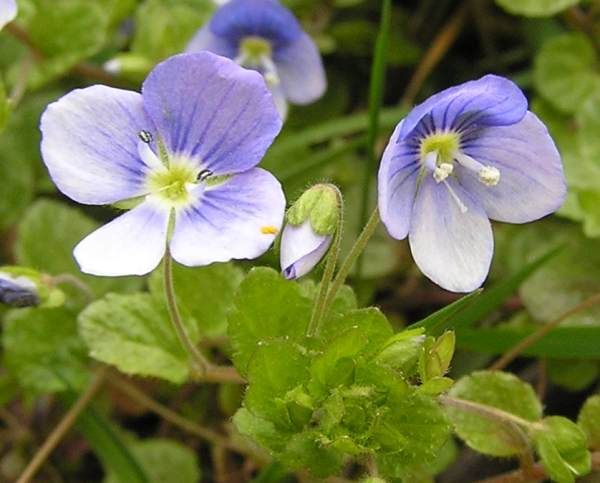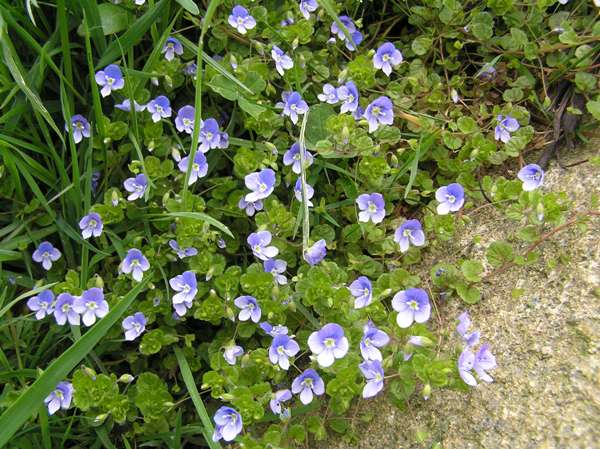Trees Birds Mammals Fish Amphibians Reptiles
Wild Algarve
Bookshop
Veronica filiformis - Slender (or Creeping) Speedwell
Phylum: Magnoliophyta - Class: Equisetopsida - Order: Lamiales - Family: Plantaginaceae

Slender Speedwell is an introduced species; it was imported as a rock garden plant from Turkey in the early part of the 19th century and has since spread into the wild. Unless supported by grasses or other strong-stemmed plants, Slender Speedwell is a sprawling, low perennial.

Description
With small round or kidney-shaped leaves that alternate along flowering stems, Slender Speedwell usually grows to a height of no more than 10 to 20cm. The four-lobed flowers, which are solitary and arise on long stalks from the leaf axils, are 8 to 10mm across; they are various shades of sky blue, pinkish blue or mauve.
Distribution
Slender Speedwell is common and widespread throughout Britain and Ireland, and it is equally abundant throughout most of northern and central mainland Europe.
Habitat
This pretty creeping flower grows in lawns, wasteland and other disturbed places; it copes well with being mowed, and fragments blown by the wind easily take root in new locations.
Blooming Times
In Britain Slender Speedwell usually blooms from April until early July.
Taxonomic note
In the past the various speedwells (of which there are many in Britain and Ireland) were classified in the family Scrophulariaceae. DNA analysis has shown that the vast array of species (some 5000 worldwide) formerly placed in the family Scrophulariaceae (the Figwort family) are not monophyletic (truly close relatives), and many genera have been transferred to other families within the Lamiales - some, as with the speedwells, are now in the family Plantaginaceae (the Plantain family); others have joined the broomrapes within the Orobanchaceae; but several new families have also been set up to accommodate groups of former 'Scrophs'.
Uses
The common name Speedwell may be a reference to the claimed rapid effectiveness of these plants when used as a medication.
Etymology
Speedwells were considered lucky charms, their sight speeding travellers on their way. Veronica, the genus name, probably comes from the Latin adjective vera- meaning true, and -nica meaning image. When St. Veronica wiped Christ's forehead on they way to his crucifixion on Mount Calvary, an image of his face was said to have been left on the cloth she had used.
The specific epithet filiformis means 'threadlike', a reference to the slender creeping stems of this speedwell species.
Similar Species
There are many Veronica species and separating them requires careful inspection of many characters; for example the flower of Germander Speedwell Veronica chamaedrys is a deeper blue and has a white central 'eye'; there are two rows of hairs along its stems..
Brooklime Veronica beccabunga grows in the edges of streams and ditches; it has thick stems, dark green leaves and sparse flowers.
The plants shown on this page were photographed in West Wales in May and June.
Sue Parker's latest ebook is a revised and enlarged edition of Wild Orchids in The Burren. Full details here...
Buy it for just £5.95 on Amazon...
Sue Parker's new ebook is a comprehensive and fully revised edition of her acclaimed field guide to the Wild Orchids of Wales. Full details here...
Buy it for just £5.95 on Amazon...
Please Help Us: If you have found this information interesting and useful, please consider helping to keep First Nature online by making a small donation towards the web hosting and internet costs.
Any donations over and above the essential running costs will help support the conservation work of Plantlife, the Rivers Trust and charitable botanic gardens - as do author royalties and publisher proceeds from books by Pat and Sue.